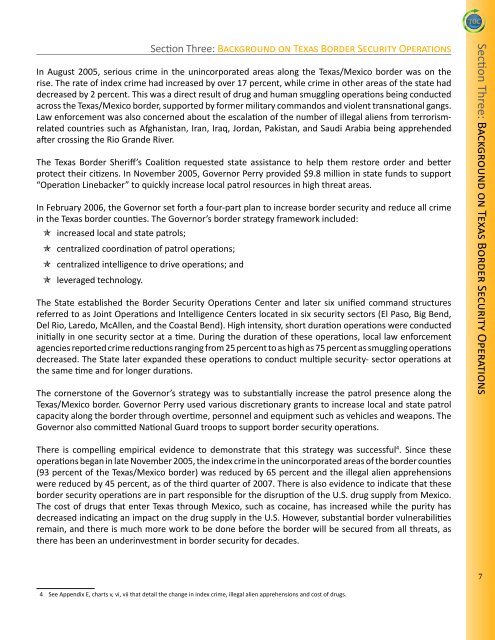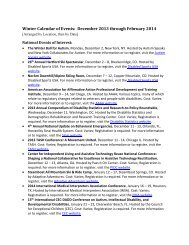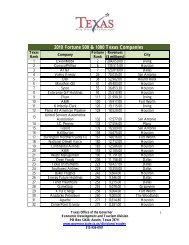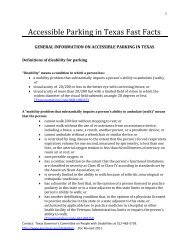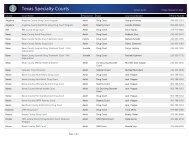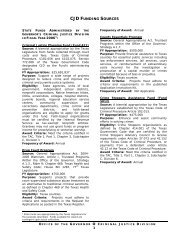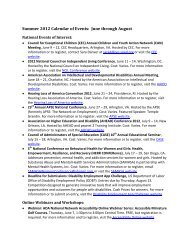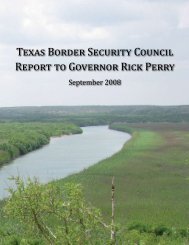Border Security Council Report - Office of the Governor - Rick Perry
Border Security Council Report - Office of the Governor - Rick Perry
Border Security Council Report - Office of the Governor - Rick Perry
You also want an ePaper? Increase the reach of your titles
YUMPU automatically turns print PDFs into web optimized ePapers that Google loves.
Section Three: Background on Texas <strong>Border</strong> <strong>Security</strong> Operations<br />
In August 2005, serious crime in <strong>the</strong> unincorporated areas along <strong>the</strong> Texas/Mexico border was on <strong>the</strong><br />
rise. The rate <strong>of</strong> index crime had increased by over 17 percent, while crime in o<strong>the</strong>r areas <strong>of</strong> <strong>the</strong> state had<br />
decreased by 2 percent. This was a direct result <strong>of</strong> drug and human smuggling operations being conducted<br />
across <strong>the</strong> Texas/Mexico border, supported by former military commandos and violent transnational gangs.<br />
Law enforcement was also concerned about <strong>the</strong> escalation <strong>of</strong> <strong>the</strong> number <strong>of</strong> illegal aliens from terrorismrelated<br />
countries such as Afghanistan, Iran, Iraq, Jordan, Pakistan, and Saudi Arabia being apprehended<br />
after crossing <strong>the</strong> Rio Grande River.<br />
The Texas <strong>Border</strong> Sheriff’s Coalition requested state assistance to help <strong>the</strong>m restore order and better<br />
protect <strong>the</strong>ir citizens. In November 2005, <strong>Governor</strong> <strong>Perry</strong> provided $9.8 million in state funds to support<br />
“Operation Linebacker” to quickly increase local patrol resources in high threat areas.<br />
In February 2006, <strong>the</strong> <strong>Governor</strong> set forth a four-part plan to increase border security and reduce all crime<br />
in <strong>the</strong> Texas border counties. The <strong>Governor</strong>’s border strategy framework included:<br />
increased local and state patrols;<br />
centralized coordination <strong>of</strong> patrol operations;<br />
centralized intelligence to drive operations; and<br />
<br />
leveraged technology.<br />
The State established <strong>the</strong> <strong>Border</strong> <strong>Security</strong> Operations Center and later six unified command structures<br />
referred to as Joint Operations and Intelligence Centers located in six security sectors (El Paso, Big Bend,<br />
Del Rio, Laredo, McAllen, and <strong>the</strong> Coastal Bend). High intensity, short duration operations were conducted<br />
initially in one security sector at a time. During <strong>the</strong> duration <strong>of</strong> <strong>the</strong>se operations, local law enforcement<br />
agencies reported crime reductions ranging from 25 percent to as high as 75 percent as smuggling operations<br />
decreased. The State later expanded <strong>the</strong>se operations to conduct multiple security- sector operations at<br />
<strong>the</strong> same time and for longer durations.<br />
The cornerstone <strong>of</strong> <strong>the</strong> <strong>Governor</strong>’s strategy was to substantially increase <strong>the</strong> patrol presence along <strong>the</strong><br />
Texas/Mexico border. <strong>Governor</strong> <strong>Perry</strong> used various discretionary grants to increase local and state patrol<br />
capacity along <strong>the</strong> border through overtime, personnel and equipment such as vehicles and weapons. The<br />
<strong>Governor</strong> also committed National Guard troops to support border security operations.<br />
There is compelling empirical evidence to demonstrate that this strategy was successful 4 . Since <strong>the</strong>se<br />
operations began in late November 2005, <strong>the</strong> index crime in <strong>the</strong> unincorporated areas <strong>of</strong> <strong>the</strong> border counties<br />
(9 percent <strong>of</strong> <strong>the</strong> Texas/Mexico border) was reduced by 65 percent and <strong>the</strong> illegal alien apprehensions<br />
were reduced by 45 percent, as <strong>of</strong> <strong>the</strong> third quarter <strong>of</strong> 2007. There is also evidence to indicate that <strong>the</strong>se<br />
border security operations are in part responsible for <strong>the</strong> disruption <strong>of</strong> <strong>the</strong> U.S. drug supply from Mexico.<br />
The cost <strong>of</strong> drugs that enter Texas through Mexico, such as cocaine, has increased while <strong>the</strong> purity has<br />
decreased indicating an impact on <strong>the</strong> drug supply in <strong>the</strong> U.S. However, substantial border vulnerabilities<br />
remain, and <strong>the</strong>re is much more work to be done before <strong>the</strong> border will be secured from all threats, as<br />
<strong>the</strong>re has been an underinvestment in border security for decades.<br />
4 See Appendix E, charts v, vi, vii that detail <strong>the</strong> change in index crime, illegal alien apprehensions and cost <strong>of</strong> drugs.<br />
Section Three: Background on Texas <strong>Border</strong> <strong>Security</strong> Operations


